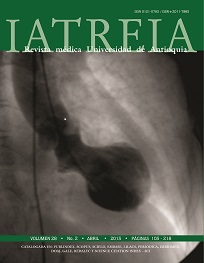Glutaric acidemia type I. Report of a case and literature review
DOI:
https://doi.org/10.17533/udea.iatreia.v28n2a09Keywords:
inborn errors of metabolism, macrocephaly, movement disordersAbstract
Glutaric acidemia type I (GA-1) is a neurological disease of metabolic ethiology. Although considered rare, it is one of the most frequent inborn errors of metabolism in Colombia. GA-1 is caused by alterations in lysine, hydroxylysine and tryptophan metabolism, resulting in the accumulation of glutaric and 3-hydroxyglutaric acids in body fluids. Clinically, it is characterized by macrocephaly, progressive cerebral atrophy, and dystonia secondary to striatal degeneration. Due to its chronic evolution, it is usually under-diagnosed, so that several years may pass before suggestive symptoms or brain imaging findings are discovered. In some patients, the disease may appear acutely triggered by an infection between 6 and 18 months of age. Due to the availability of nutritional treatment, it is necessary to make an early diagnosis and to start treatment, in order to prevent or improve complications and associated diseases. It is important to consider GA-1 in the differential diagnosis of patients with spastic or dyskinetic cerebral palsy without a clear history of hypoxic events, as well as in patients with regression in neurological development. We report a case with acute presentation to exemplify the natural history of the disease and the diagnostic approach to it.
Downloads
References
(1.) Nyhan WL, Barshop B, Ozand PT, editors. Atlas of Metabolic Diseases. 2a ed. Oxford: Oxford University Press; 2005.
(2.) Swaiman KF, Ferreiro DM, Ashwal S, Schor NF. Pediatric Neurology. New Delhi: Jaypee Brothers Medical; 2012.
(3.) Jafari P, Braissant O, Bonafé L, Ballhausen D. The unsolved puzzle of neuropathogenesis in glutaric aciduria type I. Mol Genet Metab. 2011 Dec;104(4):425-37.
(4.) Hedlund GL, Longo N, Pasquali M. Glutaric acidemia type 1. Am J Med Genet C Semin Med Genet. 2006 May;142C(2):86-94.
(5.) Kölker S, Hoffmann G F. Glutaryl-Coenzyme A dehydrogenase deficiency. Orphanet. 2003 Jun:1-5.
(6.) Viau K, Ernst SL, Vanzo RJ, Botto LD, Pasquali M, Longo N. Glutaric acidemia type 1: outcomes before and after expanded newborn screening. Mol Genet Metab. 2012 Aug;106(4):430-8.
(7.) Brismar J, Ozand P T. CT and MR of the brain in glutaric acidemia type
I: a review of 59 published cases and a report of 5 new patients. Am J Neuroradiol. 1995 Apr;16(4):675-83.
(8.) Kölker S, Christensen E, Leonard JV, Greenberg CR, Boneh A, Burlina AB, et al. Diagnosis and management of glutaric aciduria type I-revised recommendations. J Inherit Metab Dis. 2011 Jun;34(3):677-94.
(9.) Hsieh CT, Hwu WL, Huang YT, Huang AC, Wang SF, Hu MH, et al. Early detection of glutaric aciduria type I by newborn screening in Taiwan. J Formos Med Assoc. 2008 Feb;107(2):139-44.
(10.) Lee CS, Chien YH, Peng SF, Cheng PW, Chang LM, Huang AC, et al. Promising outcomes in glutaric aciduria type I patients detected by newborn screening. Metab Brain Dis. 2013 Mar;28(1):61-7.
(11.) Couce ML, López-Suárez O, Bóveda MD, Castiñeiras DE, Cocho JA, García-Villoria J, et al. Glutaric acidu-ria type I: outcome of patients with early- versus late-diagnosis. Eur J Paediatr Neurol. 2013 Jul;17(4):383-9
Downloads
Published
How to Cite
Issue
Section
License
Copyright (c) 2015 Iatreia

This work is licensed under a Creative Commons Attribution-ShareAlike 4.0 International License.
Papers published in the journal are available for use under the Creative Commons license, specifically Attribution-NonCommercial-ShareAlike 4.0 International.
The papers must be unpublished and sent exclusively to the Journal Iatreia; the author uploading the contribution is required to submit two fully completed formats: article submission and authorship responsibility.














